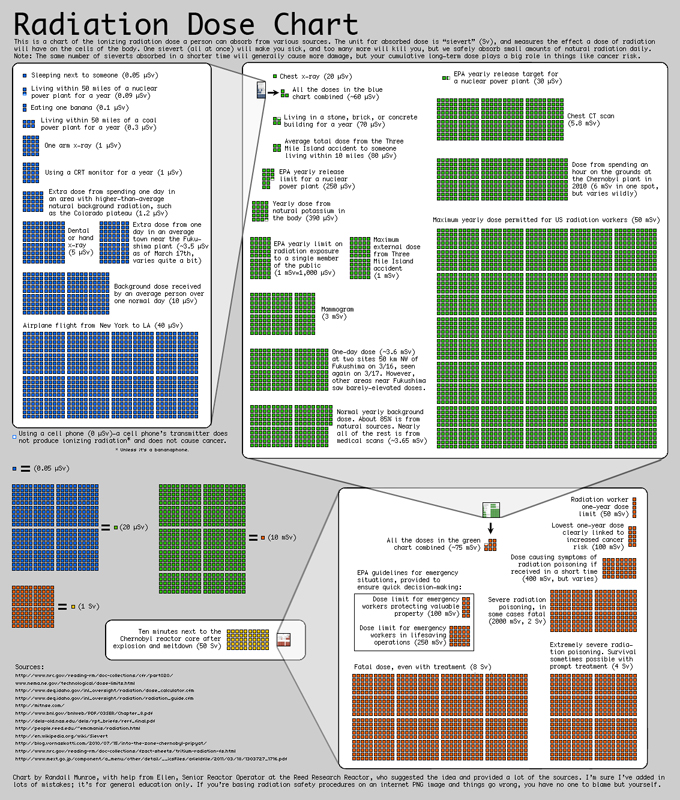Implications of radioactivity levels
Al Jazeera outlines the health risks that radiation leaks at the Fukushima Daiichi nuclear power complex pose.

 |
| On March 23, levels of radioactive iodine in Tokyo’s tap water were deemed to be at unsafe levels for infants [Reuters] |
With Japan battling a nuclear crisis at its Fukushima Daiichi nuclear power complex following the March 11 earthquake and subsequent tsunami, fears over the health implications of radiation leaks from the plant have been the foremost concerns amongst both authorities and citizens.
What is commonly refered to as ‘radiation’ is more accurately described as ‘ionising radiation’: the kind of electromagnetic wave that has enough energy to remove electrons from atoms, or even to break up the nucleus of an atom. Wavelengths for ionising radiation tend to be from 10^(-8) metres (the wavelength of ultraviolent light) and lower.
| RADIATION LEVEL IMPLICATIONS | |||||||||||||||||||
(mSv = millisieverts) |
The lower the wavelength, the higher the energy transmitted by electromagnetic waves. Thus radio waves (with wavelengths between one and 100 metres) have relatively low energy (and are therefore not potentially harmful to humans), while X-rays (with wavelengths of 10^(-10) metres) have higher energy. Gamma rays, the most dangerous kind of electromagnetic radiation, have a wavelength of the order of 10^(-12) metres.
Keep reading
list of 4 itemsWoman, seeking loan, wheels corpse into Brazilian bank
UK set to ban tobacco sales for a ‘smoke-free’ generation. Will it work?
Poland lawmakers take steps towards liberalising abortion laws
Radiation can also be transmitted through alpha (α) and beta (β) particles. Alpha particles have two protons and two neutrons (identical to a Helium nucleus), thus giving it a positive charge of +2. Beta particles are identical to electrons, and thus have a negative charge of -1. All of the radioactive elements listed below emit beta particles, and not alpha particles.
Exposure to large amounts of high-energy radioactivity can cause nausea, vomiting, hair loss, diarrhoea, haemorrhaging, destruction of intestinal lining, central nervous system damage and death. It can also cause DNA damage and raise the risk of cancer, particularly in young children.
Below are the three radioactive substances health experts have been most concerned about after the radiation leaks at the Fukushima plant.
Radiation levels are provided in becquerels (Bq), a unit of measuring radioactivity. One becquerel is defined as that quantity of a material that will undergo one nucleus decay per second. In a fixed mass of substance, becquerel readings change with time, to indicate how radioactive they may be at any given moment. A vegetable with a certain becquerel reading for a radioactive element, therefore, will see that number decrease steadily unless exposed to further radiation.
Absorbed radiation is measured in Sieverts (Sv), a unit that attempts to quantify the biological effects of ionising radiation.
The table to the right shows the effects of short-term, high-level exposure to radiation (measured in millisieverts), as published by the US Environmental Protection Agency.
| Iodine-131 |
Leafy green vegetables in several prefectures near the Fukushima plant – Fukushima, Ibaraki, Tochigi and Gunma – have been found to contain up to 22,000 becquerels of iodine-131 for every kilogram.
These levels are 11 times those set by the European Union as safety standards.
Eating a kilogram of such vegetables would give the person consuming it half the amount of radiation an average person is typically exposed to from the natural environment in a year.
Eating a kilogram every day for 45 days would accumulate 50 millisieverts (mSv), the annual radiation limit set for nuclear plant workers.
Exposure to 100mSv per year increases a person’s risk of cancer. It is the equivalent of approximately three full-body CT scans.
If inhaled or swallowed, iodine-131 concentrates in the body’s thyroid gland and increases the risk of thyroid cancer. Children, fetuses and young adults are particularly vulnerable to this risk.
The risk of thyroid cancer can be lowered by the ingestion of potassium iodide pills, a compound that helps to prevent the absorption of the radioactive iodine.
Iodine-131 does, however, disintegrate relatively quickly, with its radioactivity levels halving every eight days. Based on the levels of radioactivity measured on March 24, it would lose its harmfulness in 80 days.
| Caesium-134 and Caesium-137 |
Vegetables in Japan have also been found to be tainted with up to 14,000Bq of caesium per kilogram.
Again, this exceeds EU guideline limits by 11 times.
Eating a kilogram of such vegetables every day for 30 days would accumulate the equivalent radiation of a full body CT scan, or 20mSV.
External exposure to large amounts of radioactive caesium can also cause burns, acute radiation sickness and death, depending on the amount of exposure.
Ingesting or inhaling caesium allows it to be distributed in the body’s soft tissue, particularly muscle tissue, increasing the risk of cancer.
It can also cause spasms, involuntary muscular contractions and infertility.
Unlike iodine, the uptake (absorption) of radioactive caesium cannot be prevented once a person has been exposed to it.
Caesium is also particularly dangerous because it has a much longer radioactive half-life than iodine-131. Caesium-137 takes 30 years for its radioactivity to half, meaning that it would take 240 years for this contaminant to exhaust its dangerous radioactivity, based on March 24 levels.
Caesium-134 has a half-life of two years, meaning that it would take about 20 years for it to become harmless.
| Typical sources and levels of radiation |
The chart below shows typical sources and estimated levels of radiation (in Seiverts) that an average person is exposed to, compared to both EPA guidelines and harmful doses. While the creator, Randall Munroe, explicitly states that it is not meant to serve as a basis for radiation safety procedures, it does serve as a useful guide.
 |
| This chart compiled by the XKCD webcomic shows typical levels and sources of radiation exposure |
